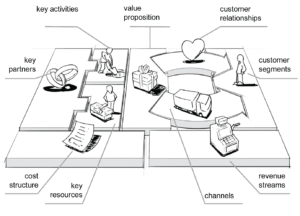The beauty of questions in developing your marketing plans
Door Arthur Simonetti *
“One of the great skills of a marketer should be the drawing of a matrix: a 2-axis diagram allowing you to plot every market opportunity, product and competitor, so that ALL dynamics and issues can be explained.” At least, this is the perception non-marketers have of the marketing profession; and to a certain extent, they are right: unskilled marketers abuse models and create new ones too readily.
For me the true value of a model lies in the power with which it supports your decision making through asking QUESTIONS: questioning your assumptions and questioning your consistency. A good model helps you to open up and structure a dialogue, whether this dialogue is with your team (which is preferred), or with yourself. A model is ONE WAY of looking: it’s a lens through which to view reality. As soon as the model is used as a dogmatic representation of reality it loses its value.
A good example of model abuse is the poor Product Life Cycle. It has been used many times to explain the position of a product and predict its future. It’s hardly surprising when it becomes a self-fulfilling prophecy. At the moment it is more creatively used to trigger questions to create more value, such as: how to rejuvenate my product? What is the maturity of competitive products? Are we still a winner? Is the life cycle of the product category similar to our product? Here, there are no answers, just questions!
My top 3 Marketing Models
In my daily practice I use a limited number of models to help me ask pertinent questions and thereby improve my decision making. These models focus on what I would categorize as CONSISTENCY CHECK MODELS.
Number 1: The clover model
My first model is a model I designed in the 90’s, which I call the Clover model (see fig1). It consists of 2 dimensions; the internal-external dimension and the Want and Ability dimension. This combination delivers 4 quadrants that cover the 4 most important questions you should ask yourself in building a strategy. These questions are:
- INTERNAL WANT; what is your ambition? What do you want to achieve?
- EXTERNAL WANT; what does the customer NEED? What does the market want?
- EXTERNAL ABILITY; what is possible in the market, given the competition?
- INTERNAL ABILITY; which competencies do you have to fulfill your ambition and the market need?
It doesn’t matter where you start: sometimes you start with a market opportunity, sometimes with your ambition. The most important is that you answer all quadrants and that your answers are logically aligned and coherent. I have used this model both in strategy workshops to stimulate the dialogue and as a consistency check for written marketing plans.
Number 2: The industry dynamic model
The second model is called the industry dynamic model which is a nice second generation Porter’s 5 forces model, integrated with a PESTEL and Value Chain analysis. I wrote about this in an earlier blog post. https://www.linkedin.com/pulse/marketing-314-b2b-marketeer-success-factor-arthur-simonetti?trk=pulse_spock-articles
This framework is built around five questions, with the answers being visually aligned in blocks (horizontally and vertically, see figure 2):
- Where is the value in the value chains?
- Who are the key players?
- Who has the power?
- Who are the influencers?
- What are the trends and what is the impact?
During the creation of the visual analysis, and at the moment the full picture is ready, questions and discussions are triggered. It will help teams to have a structured dialogue to support decision making regarding the position in the value chain and the winning propositions, as well as providing an in-depth understanding of the true dynamics shaping your market.
Number 3: The Osterwalder Canvas http://businessmodelgeneration.com/canvas/bmc
My final favorite CONSISTENCY CHECK model is the Osterwalder Canvas. In this case, too, key questions integrated into an overall picture help decision making to build a consistent and coherent business model. I use the model to accommodate 3 dialogues substantiated by the 9 building blocks;
- What do we offer to whom?
- What is our target segment and what problems do we solve?
- What do we offer? What is our value proposition?
- How do we reach our customers?
- What relationships do we have with our customers?
- What capabilities are needed?
- What are the necessary key activities?
- What are the key resources and capabilities needed to make it a success?
- Which key partners will help to complement our own competencies?
- What is the financial attractiveness?
- How do we make money? What is the revenue model?
- What is the cost structure?
With these 3 models in my back pocket I am able to structure many strategic and marketing discussions. Not by giving answers or explanations, but simply by asking questions. This creates space for different perspectives and creative solutions, culminating in a coherent story and line up. A line up that connects the “outside in” with the “inside out” and allows us to make decisions and choices.
The right use of models in marketing definitely adds value and strengthens your story!
* Arthur Simonetti is Marketing Director bij DSM en voorzitter van de NIMA B2B Marketing Community



